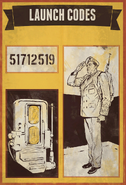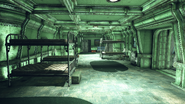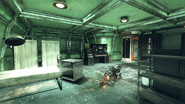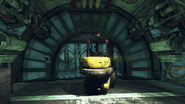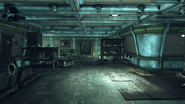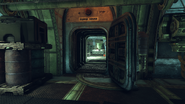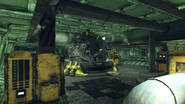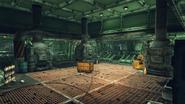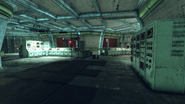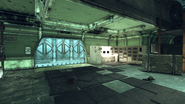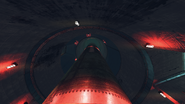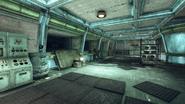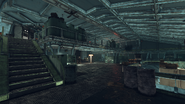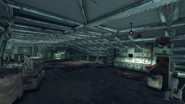The Appalachian Automated Launch System refers to the network of three nuclear silos built in Appalachia before the Great War, intended to provide the United States with a reliable second-strike option in case of a nuclear attack. The system consists of three missile silos spread across the Appalachians (Alpha, Bravo, and Charlie), controlled from the command center at the Whitespring bunker.
Background[]
The construction of an automated network of silos in Appalachia was firmly opposed by Senator Sam Blackwell, who raised objections to the discrepancies between military and civilian warning systems. He was silenced with a threat of imprisoning him for sowing dissension and inciting panic.[1]
The silos were designed to be used with a minimum of human oversight, with one exception: Launching nuclear weapons. The system relied on single-use nuclear keycards, which were delivered through logistics officers and automated Strategic Air Command cargobot deliveries to the region. To authorize a nuclear strike, the keycard was just the first step. The general ordering the launch also had to input the correct launch code. [2] To prevent misuse of Appalachia's automated missile silos, security measures for the region's nuclear arsenal were complex. Each silo had its own eight-digit launch code, which was valid for a single week. These codes were broken into eight individual number/letter pairs, each carried by a designated officer who was under strict orders to guard their code piece with their life.[3] The order of the numbers was encrypted using a series of methods to prevent improper deployment. It was the job of the Whitespring bunker's staff of specially trained code-decrypters to provide the officer corps with the code when it was renewed each week.[4]
The silos themselves were designed to be able to launch nuclear weapons at a moment's notice. To that end, they were equipped with an advanced robotic construction system, allowing them to rapidly refill their arsenals in a matter of hours. The silos were also defended by a robotic task force and staffed with a contingent of special-clearance human missileers. Security protocols required all silo entrants, regardless of rank, to be escorted by a missileer at all times. Entering a silo without escort would be treated as a hostile act regardless of rank.[5] Moreover, the military specialists in charge of the silo, the aforementioned missileers, were rotated every six months. They were the only ones permitted inside the maximum-security Class VI sites. Everyone else, with the sole exception of officers of rank OF-9 (General) or above, with a preauthorized missileer escort, would be shot on sight.[6]
Due to the sophistication and purpose of the system, the military was aware that a retaliatory strike could touch down somewhere in Appalachia.[7] However, as fate would have it, no retaliatory strike landed in Appalachia as the missile silos never fired their payloads when the Great War came in 2077. The reasons differed between the silos. In Silo Alpha, the general responsible for authorizing the nuclear keycard made a mistake when inputting the code, losing the only nuclear keycard assigned to the silo. The soldiers were ordered to evacuate at 0600 the following day, with the missileers hoping the incompetent general would be court-martialed.[8] At Bravo, the general never arrived, with the missileers abandoning the site. Only a single private, Jeffers, stayed behind. He eventually lost his mind, starting to chase an imagined infiltrator before deciding that he was the infiltrator and abandoning the site as well, to turn himself in.[8] Finally, site Charlie was evacuated due to a radiation leak from the missiles. The leak was non-existent, a result of an error in the radiation sensors that were detected by automated daily maintenance. The lockdown was promptly lifted - one day after the Great War.[8]
The silos have remained inert since maintained by its robotic staff for the foreseeable future. They remained intact for decades, and were coveted by Thomas Eckhart's Enclave (before its extinction) and eventually used by the Vault Dwellers to contain the scorchbeast threat.
Design[]
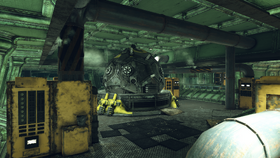
All automated missile silos utilize a high-redundancy power infrastructure, capable of drawing power from the civilian grid, onsite reactors, and onsite fusion megacells.[9] In the event of a power system failure, the silo's Power House will automatically switch to the next available power source. Each silo has been equipped with one Class-VIII fusion reactor and three Class-IV fusion reactors, connected in a closed circuit.[9] These reactors were capable of serving as the silo's primary power source indefinitely.[9] In the event of a reactor breach, an automated security lockdown would seal the Power House facility to limit radioactive contamination and authorized engineers would be expected to report to the Reactor Control Terminal to initiate repairs. Due to the high pressures present in a Class-VIII reactor, the reactor system had to be shut down before repairs could be attempted.[9] However, due to security and operational readiness requirements, the system was designed to automatically restart after a period of time dependent on the DEFCON status. Understandably, repairs had to be completed within the allotted time.[9]
The power plant provided the electricity necessary for the silo and its staff to function. One of the most power-hungry facilities was the Operations Center, responsible for operational security and readiness, external communications, and, in the event of a nuclear conflict, coordinating tactical and joint strike operations with other military units.[10] Its core was a RobCo GX-9000 mainframe, capable of fully autonomous operation. While powerful, individual mainframe cores were fragile and subject to damage or burnout.[10] Replacement cores have been stocked in the Storage facility to meet ongoing maintenance needs, although damaged cores could also be reliably repaired by capable electronics specialists.[10] Right after it came the advanced robotic construction system at each Automated Missile Silo. Following a successful launch, construction of a new missile would begin immediately, with the silo entering an automated lockdown state for the duration of the reconstruction process to allow for decontamination, automated maintenance, and security sweeps. During this time, all personnel would be instructed to evacuate the silo and remain in the designated shelter area until the all-clear is given.[11]
For security, silos use the Advanced Biometric Identification System v.4.0.9. The ABIS was responsible for authenticating military personnel at facilities requiring Class-VI security clearance (i.e. top level security clearance) and valid biometric cards could be rapidly created using on-site scanners to compile encrypted biometric data and loading them up using ABIS fabricators. All that was left was entering them into the system. [12] Combined with the strict security clearance requirements, the missile silo was virtually impenetrable. However, to prevent an accidental or malicious nuclear launch, the silo employed additional interlocking failsafes. A missile could only be launched at DEFCON 1, had to be assembled and staged, launch preparations had to be completed, and only then could the final launch authorization (keycard and code) be supplied.[11]
These layers of security were necessary, as the automation extended to the Launch Crew: Launch Crew Chiefs replaced regular missileers. These were specialized Protectrons with the encryption keys and operating instructions required to prepare a missile for launch. Although each Crew Chief was optimized for its role, launch prep could proceed as long as at least one Crew Chief remained operational, albeit more slowly. Fabrication terminals could replace them as needed. Of course, since Crew Chiefs did not verify the orders, all security units were programmed to destroy the Crew Chiefs autonomously to halt Launch Prep in case of a security incident.[11]
Gallery[]
- Command center (Whitespring)
- Missile silos
See also[]
References[]
- ↑ Back off Sam
- ↑ The Whitespring bunker nuclear training: " Greeting, general. Welcome to your nuclear launch training session. Over the course of the next four posters, you'll be taught everything you need to know about utilizing the Appalachian Automated Launch system. During your briefing, you should've been issued a Nuclear Keycard. During an actual launch, you will need to insert the card into the designated slot before entering your launch code, at which point the keycard will be consumed. Additional card drops will be brought in by automated convoy should the DEFCON rating continue to worsen. You may speak to your logistics officer as to the location of the pick-up for your additional cards, should the circumstances arise."
MODUS: "The silver lining of this is that one can often find a keycard convoy en route somewhere in Appalachia. We're happy to use our restored surveillance tools to help you track them. Access any of the surveillance system terminals to initiate your hunt." or "As we said, DEFCON has been permanently pegged at its highest level thanks to the actions of our earlier guests. Over the course of the next four posters, you'll be taught everything you need to know about utilizing the Appalachian Automated Launch system. Just visit one of our surveillance terminals if you'd like our help in seeking them out." - ↑ The Whitespring bunker nuclear training: "{{tooltip| To prevent misuse of Appalachia's automated missile silos, security measures for the region's nuclear arsenal have been increased well beyond any of our existing standards. Each silo has its own eight-digit launch code, which is valid for a single week. These codes are broken into eight individual number/letter pairs, each carried by a designated officer who is under strict orders to guard their Code Piece with their life."
- ↑ The Whitespring bunker nuclear training: " To prevent misuse of Appalachia's automated missile silos, security measures for the region's nuclear arsenal have been increased well beyond any of our existing standards. Each silo has its own eight-digit launch code, which is valid for a single week. These codes are broken into eight individual number/letter pairs, each carried by a designated officer who is under strict orders to guard their Code Piece with their life. The order of the numbers has been encrypted using a series of methods to prevent improper deployment. The bunker's staff of specially trained code-decrypters will provide the officer corps with the code when it is renewed each week. "
MODUS: "With the decrypters deceased, it falls to you and your compatriots to crack each week's codes. We would suggest starting your hunt with the archives on this floor. All the remaining information we have on the nature of the codes is stored there. And if you'd rather get busy collecting code pieces, simply step over to the surveillance terminals. That, at least, we can help you with." - ↑ The Whitespring bunker nuclear training: " The missile silos of Appalachia are equipped with an advanced robotic construction system, allowing them to rapidly refill their arsenals in a matter of hours. The silos themselves are defended by a robotic task force and staffed with a contingent of special-clearance human missileers. Security protocols require all silo entrants, regardless of rank, be escorted by a missileer at all times. Entering a silo without an escort will be treated as a hostile act."
MODUS: "We're unable to peer inside the silos themselves, but we are confident in saying we doubt any such escort still lives. You will be on your own once you're through the door." or "Said missileers are almost guaranteed dead. You will need to soldier on through the silos without them. We recommend bringing friends." - ↑ Missile silo terminal entries: "SECURITY PROTOCOL - GENERAL"
- ↑ The Whitespring bunker nuclear training: "Due to the region's advanced missile installations, there is a high chance of a retaliatory nuclear strike touching down somewhere in Appalachia. The intense radiation released by such a blast can have devastating effects on local flora and fauna... ... mutating them into hideous monstrosities fit only for a quick death."
- ↑ 8.0 8.1 8.2 Missile silo terminal entries - Residential Terminal
- ↑ 9.0 9.1 9.2 9.3 9.4 Missile silo terminal entries - Power System Overview
- ↑ 10.0 10.1 10.2 Missile silo terminal entries - Operations Center Terminal
- ↑ 11.0 11.1 11.2 Missile silo terminal entries - Launch Control Terminal
- ↑ Missile silo terminal entries - Biometrics System Terminal



